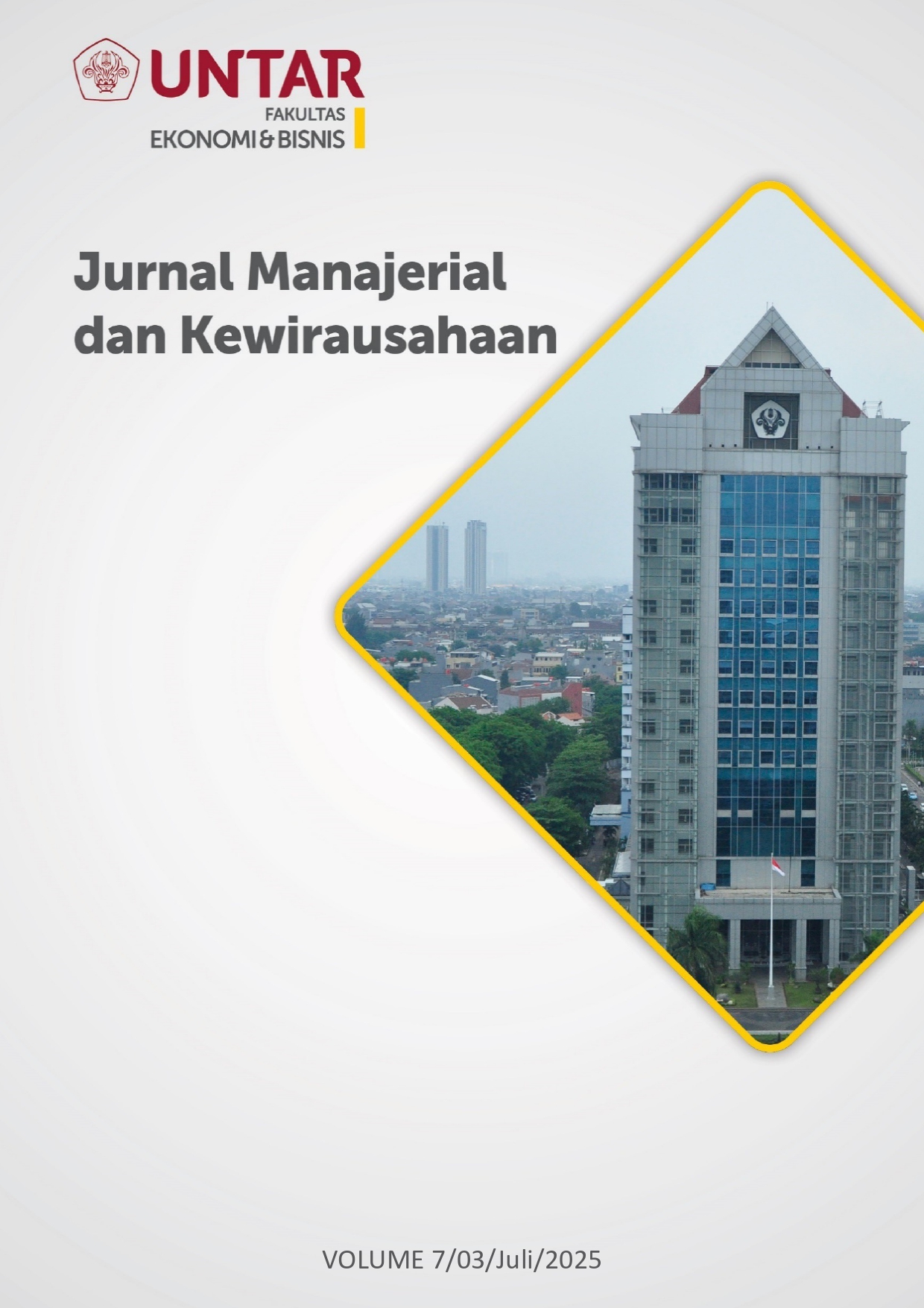Faktor yang Berperan dalam Peningkatan Purchase Intention Paket Kombo Restoran Cepat Saji Indonesia
Main Article Content
Abstract
Restoran cepat saji telah menjadi bagian dari gaya hidup modern dan melesatnya pertumbuhan restoran cepat saji dalam beberapa tahun terakhir. Mayoritas restoran cepat saji berinovatif menjadi yang lebih unggul dengan menyediakan paket kombo yang dijadikan sebagai andalan utama restoran cepat saji. Penelitian ini bertujuan untuk menganalisa faktor-faktor yang berperan dalam peningkatan purchase intention paket kombo restoran cepat saji di Indonesia, dalam penelitian ini faktor-faktor yang dianalisa adalah Social Media Marketing, lalu Trust dan Reputation sebagai mediasi. Teknik pemilihan sampel yang digunakan penelitian ini adalah purposive sampling. Sampel yang ada dalam penelitian ini merupakan pelanggan atau konsumen yang pernah mencoba atau mengetahui paket kombo pada restoran cepat saji di Indonesia. Data yang dikumpulkan berjumlah sebanyak 206 responden. Data diolah menggunakan aplikasi SmartPls 4.0. Data penelitian ini menunjukkan hasil bahwa social media marketing berpengaruh positif dan signifikan terhadap trust dan reputation, begitu juga dengan trust dan reputation yang berpengaruh positif dan signifikan terhadap purchase intention, mediasi dari trust dan reputation berhasil menghubungkan social media marketing dengan purchase intention menunjukkan hasil positif dan signifikan dengan efek mediasi parsial.
Fast food restaurants have become a part of modern lifestyle, and the rapid growth of fast food restaurants in recent years has been remarkable. The majority of fast food restaurants have innovated to gain a competitive edge by offering combo meal packages, which have become a key feature of these establishments. This research aims to analyze the factors that influence the increase in purchase intention for fast food restaurant combo packages in Indonesia. The factors analyzed in this study include Social Media Marketing, with Trust and Reputation acting as mediators. The sampling technique used in this study is purposive sampling. The sample consists of customers who have tried or are familiar with combo meal packages at fast food restaurants in Indonesia. A total of 206 respondents were surveyed. The data were processed using SmartPLS 4.0 software. The results of the study indicate that social media marketing has a positive and significant effect on trust and reputation, and trust and reputation also have a positive and significant effect on purchase intention. The mediation of trust and reputation successfully links social media marketing with purchase intention, showing a positive and significant result with a full mediation effect.
Article Details

This work is licensed under a Creative Commons Attribution-NonCommercial-ShareAlike 4.0 International License.
This work is licensed under a Jurnal Muara Ilmu Ekonomi dan Bisnis Creative Commons Attribution-ShareAlike 4.0 International License.,/p>
References
Bicchieri, C., Duffy, J., & Tolle, G. (2004). Trust among strangers. Philosophy of Science, 71(3), 286-319. http://dx.doi.org/10.1086/381411
Blomqvist & Ståhle. (2004). Building Organizational Trust. Lappeenranta University of Technology and Sonera Research.
Cynthia, & Tunjungsari, H. K. (2021). Pengujian faktor-faktor yang membentuk niat pembelian konsumen Saladstop. Jurnal Muara Ilmu Ekonomi dan Bisnis, 5(2), 469-483. https://doi.org/10.24912/jmieb.v5i2.13346
Evans et al. (2013). Social Media Marketing : The Next Generation Of Business Engagement. International Journal Of Management Research and Review, 2461-2468.
Hair et al. (2014). Partial least squares structural equation modeling (PLS-SEM) an emerging tool in business research. European Business Review Vol. 26(2), 106-121.
Handoko, G. W. W., & Tunjungsari, H. K. (2022). Analisis dampak aktivitas sosial media marketing terhadap niat beli konsumen: studi kasus Healty Food di Indonesia. Jurnal Manajemen Bisnis dan Kewirausahaan, 6(4), 421-426. https://doi.org/10.24912/jmbk.v6i4.19342
Keegan et al. (2023). Customer Purchase Intention In A Local Fast Food Restaurant : Testing The Role Of Social Media Marketing Activites. Joural of Social Research, 2358-2361.
Mayer et al. (1995). An Integrative Model Of Organizatioonal Trust. The Academy of Management Review, 709-734.
Mehrabian & Russel. (1974). An approach to environmental psychology. The MIT Press.
Mirabi et al. (2015). A Study of Factors Affecting on Customers Purchase Intention Case Study : The Agencies of Bono Brand Tile in Tehran. Journal of Multidisciplinary Engineering Science and Technology, 267-273.
Nurhayani & Abadi. (2024). Pengaruh EWOM, social media usage, brand image dan firm's brand reputation terhadap purchase intention. Jurnal Ilmiah Manajemen Ekonomi dan Akuntansi, 1600-1629.
Sadom et al. (2023). The Relationship Between Social Media Marketing, Trust, Reputation and Purchase Intention : Empirical Evidence from Fast-Food Industry. Journal of Intentional Food & Agribusiness Marketing, 1-29.
Salhab et al. (2023). The Impact of social media marketing on purchase intention : the mediating role of brand trust and image. International journal of data and network science 7, 591-600.
Samsu. (2017). Metode Penelitian : Teori dan Aplikasi penelitian kualitatif, kuantitatif, mixed methods, serta research & development. Pusat Studi Agama dan Kemasyarakatan (PUSAKA).
Selly & Purba. (2021). Faktor-Faktor Yang Mempengaruhi Purchase Intention Pada Brand Man Man Tang Di Batam. Scientia Journal, 2.
Shah et al. (2012). The Impact of Brands on Consumer Purcahse Intentions. Asian Journal of Business Management, 105-110.
Sugiyono. (2017). Metode Penelitian Kuantitatif, Kualitatif, dan R&D. Bandung: Alfabeta, CV.
Trianasari et al. (2023). The influence of social media marketing and influencer endorsement through brand image and trust, and their impact on the purchase intention of the MS Glow brand through the TikTok application. International Journal Of Professional Business Revieww, 01-23.
Tuten & Salomon. (2018). Social Media Marketing. Los Angeles: SAGE.
Zulkarnain & Helmi. (2023). The influence of service quality, product attributes, and company reputation that affect consumer buying interest. Jurnal Ekonomi Vol. 12(4), 171-181.



